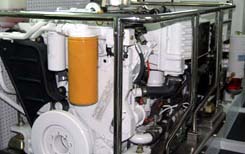Call Us: 855.266.5676 | 954.684.0218
Email Us: info@curtisstokes.net 
Call Us: 855.266.5676 | 954.684.0218
Email Us: info@curtisstokes.net 
By Capt. Barry Kallander

The most common cause of wear in a diesel engine is contamination of the crankcase oil. The number one contaminant is “dirt.” Seen on the oil analysis report as elevated silicon, dirt enters the engine through a perforated or filthy air filter, a leak in the air intake piping, or faulty oil change procedures. Small amounts of dirt (PPM) will immediately result in higher levels of wear metals like iron, chrome, and nickel on the report.
The number two contaminant, water, results in accelerated wear due to the reduced lubricating ability of the oil. Emulsified oil will be seen on the report as a percentage of water as well as reduced viscosity. The most common sources of water are leaky heat exchangers, failed gaskets, or condensation. Water will accelerate wear rates long before you visually detect emulsified oil on the filler cap.
Fuel contamination and soot result from reduced combustion efficiency or excessive wear in the piston/cylinder interface. Fuel contamination reduces the viscosity of the oil and therefore it’s lubricating ability. Fuel dilution and soot are seen as percentages on the analysis report and will quickly result in an increase in wear metal particles.
Oil analysis is the only method to detect minor contamination problems before they start causing major damage to your engine. Try WheelHouse Oil Analysis—it’s cheap insurance for your engine.

© 2024 Curtis Stokes & Associates, Inc. | All rights reserved.